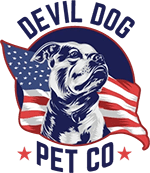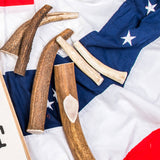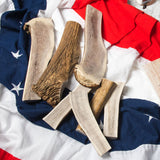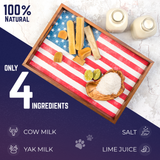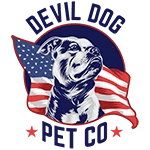Key Takeaways
- The best antler for dog chewing is a Grade-A+ Rocky Mountain elk antler.
- The antler should be longer than your dog's jaw to ensure safety.
- Replace the antler when it becomes small enough for your dog to swallow.
- Devil Dog Pet Co.'s naturally shed elk antlers offer maximum safety, longevity, and dental benefits.
- Selecting the right antler prevents broken teeth, choking hazards, and wasted money.
Table of Contents
- Why Antler Chews Matter, Benefits, Risks, and the Marine Standard
- Antler Types and Species, Elk, Deer, Moose Breakdown
- How to Spot Antler Quality, Grades, Freshness, and the Real Deal
- Picking the Right Cut, Whole, Split, Medallion, and Specialty Shapes
- Size & Density, Match the Antler to Your Dog's Strength
- How to Introduce and Use Antler Chews, Boot Camp for Success
- Safety Protocols, Supervision, Dental, and Digestive Captain's Orders
- Antler Chews vs. Other Natural Chews, Practical Comparison
The Best Antler for Your Dog, A Complete Owner's Field Guide
Finding the best antler for dog enrichment isn't about settling for "good enough", it's about matching premium quality to your pup's specific needs. With dozens of species, cuts, and grades flooding the market, most owners grab the first antler they see and hope for the best. That's a recipe for broken teeth, choking hazards, and wasted money. For large breeds or aggressive chewers, the Jumbo Whole Elk Antler Dog Chew is a top choice for durability and safety.
The truth? Grade-A+ elk antlers sourced from wild Rocky Mountain sheds consistently outperform deer, moose, and farm-raised alternatives in safety, durability, and palatability. When sized correctly and introduced properly, they transform destructive chewers into focused, calm dogs while scraping plaque and delivering essential minerals. For smaller dogs or first-time chewers, the Small - Split Elk Antler Dog Chew - 2 Pack provides a gentle, nutrient-rich introduction to antler chewing.
To explore a full range of options tailored to your dog's size and chewing style, browse the Premium Grade-A Elk Antler Dog Chews (Whole & Split Cuts) collection for the best antler for dog safety and satisfaction.
Why Antler Chews Matter, Benefits, Risks, and the Marine Standard
Premium antler chews deliver what rawhide and synthetic toys can't: weeks of engagement, zero digestive blockages, and natural dental cleaning. The dense bone matrix scrapes plaque while releasing calcium, phosphorus, and zinc, nutrients that support bone health and jaw strength. Unlike bully sticks or yak chews, antlers produce no odor, mess, or staining.
The hardness that makes antlers durable also creates risk. Power chewers who bite straight down can crack molars, and undersized pieces become choking hazards. Proper sizing, always longer than your dog's jaw, and supervision during early sessions eliminate most dangers. Dogs with weak teeth, aggressive swallowing habits, or a history of dental fractures need softer alternatives.
Core Benefits of Antler Chews
- Natural mineral boost: Calcium, phosphorus, zinc support dental and bone health
- Plaque removal: Grinding action scrapes tartar buildup
- Mental stimulation: Releases endorphins, reduces anxiety and boredom
- Zero mess: Odorless, stain-free, leaves only light mineral dust
- Sustainable sourcing: Naturally shed by wild elk, eco-friendly
Antler Types and Species, Elk, Deer, Moose Breakdown

Species selection determines hardness, marrow content, and safety profile. Elk antlers strike the perfect balance, dense enough for weeks of chewing yet manageable for most jaw strengths. Deer antlers test harder but carry higher fracture risks, while moose paddles wear down quickly despite rich marrow content. For a detailed breakdown, see this comprehensive comparison of deer antler vs elk antler for dogs.
Elk Antlers, The All-American Endurance King
Best for: Moderate to heavy chewers seeking maximum longevity
Rocky Mountain elk antlers deliver consistent density, accessible marrow when split, and predictable wear patterns. The smooth grinding action prevents dangerous splintering while lasting weeks for most dogs. Start with whole antlers for experienced chewers, splits for newcomers.
Deer Antlers, Hardcore but High Risk
Best for: Ultra-power chewers under strict supervision
Whitetail antlers rank hardest among common species but offer minimal marrow and higher splinter potential. Mule deer provides slightly more marrow with comparable hardness. Reserve for dogs who demolish elk antlers too quickly and have proven gentle chewing styles.
Moose Antlers, Maximum Marrow, Minimum Wear
Best for: Light to medium chewers prioritizing flavor
Paddle-shaped moose antlers pack the most marrow but wear fastest due to softer density. Ideal for senior dogs, gentle chewers, or as high-value training rewards. Expect days to one week of chew time versus weeks from elk.
| Species | Hardness | Marrow Content | Longevity | Best For |
|---|---|---|---|---|
| Elk | Medium-High | High | 2-4 weeks | Most dogs, balanced choice |
| Whitetail Deer | Highest | Low | 3-5 weeks | Ultra-power chewers only |
| Mule Deer | High | Medium | 2-3 weeks | Heavy chewers |
| Moose | Low-Medium | Highest | 3-7 days | Light chewers, seniors |
How to Spot Antler Quality, Grades, Freshness, and the Real Deal
Grade determines everything from palatability to safety. Grade-A+ antlers, representing the top 5% of all sheds, maintain a fresh brown sheen, maximum mineral density, and predictable wear patterns. Lower grades turn chalky white, splinter unpredictably, and offer minimal nutritional value despite cheaper prices.
Quality sourcing matters as much as grade. Wild-shed Rocky Mountain elk antlers outperform farm-raised alternatives because natural shedding preserves the bone matrix integrity. Avoid any supplier using bleach, dyes, or chemical treatments, these processes weaken the antler structure and eliminate beneficial minerals.
Grade Breakdown, Why Grade A+ Reigns Supreme
Grade A+: Fresh brown color, highest palatability, maximum durability, weeks of safe chewing
Grade A: Light brown to tan, reliable quality, good value for most dogs
Grade B-C: White or chalky appearance, brittle texture, higher splinter risk, avoid entirely
| Grade | Appearance | Durability | Safety Level | Best Use |
|---|---|---|---|---|
| A+ | Fresh brown | Weeks+ | Highest | All dogs, maximum value |
| A | Brown/tan | 1-3 weeks | High | Reliable daily chewing |
| B-C | White/chalky | Days | Poor | Not recommended |
Picking the Right Cut, Whole, Split, Medallion, and Specialty Shapes
Cut selection determines chew duration and difficulty level. Whole antlers provide maximum longevity for experienced chewers, while splits expose marrow for instant gratification. Medallions and base cuts offer the densest chewing challenge but require strong jaws and careful supervision. If your dog prefers easy marrow access, the Large - Split Elk Antler Dog Chew - 1 Pack is a great option for flavor and engagement.
Whole Antlers, Built for Endurance
Best for: Moderate to heavy chewers seeking weeks of engagement
Intact antler sections force dogs to work the entire surface, maximizing chew time and dental benefits. Size must exceed your dog's jaw length, never give an antler that fits between back molars. Perfect for dogs who demolish other chews too quickly. For medium-sized breeds, the Medium THICK Whole Elk Antler Dog Chew offers the right balance of density and size.
Split Antlers, Maximum Marrow, Faster Finish
Best for: Puppies, seniors, picky eaters, and first-time antler users
Lengthwise cuts expose nutrient-rich marrow, providing immediate flavor rewards. Expect shorter lifespan than whole antlers, size up one level for serious chewers. Ideal introduction to antler chewing with lower tooth stress.
Medallions and Base Cuts, Professional Grade Challenge
Best for: Power chewers who need maximum density
Base sections contain the hardest, most mineral-dense antler material. These thick, round cuts last longest but require strong adult molars and proven gentle chewing technique. Premium pricing reflects superior durability.
Sizing Rule: Always choose antlers longer than your dog's lower jaw and too thick to fit between back molars. When in doubt, size up, oversized antlers are safer and last longer.
Size & Density, Match the Antler to Your Dog's Strength

Proper sizing prevents choking and maximizes value. The best antler for dog safety measures longer than the lower jaw and thicker than the gap between back molars. Weight guidelines provide starting points, but jaw strength and chewing style determine final selection. For extra-large breeds, the Extra Large (XL) Whole Elk Antler Official Dog Chew is designed to withstand the toughest jaws.
Density matching matters as much as size. Power chewers need whole antlers or medallions with maximum thickness, while casual gnawers succeed with splits or thinner cuts. Aggressive biters require supervision regardless of antler type, their technique poses higher tooth fracture risk.
Sizing by Weight and Jaw Strength
Use your dog's weight as a baseline, then adjust for individual chewing intensity. A 40-pound gentle chewer needs a smaller antler than a 40-pound destroyer. Measure your dog's lower jaw length and add 2 inches minimum for safe sizing.
| Dog Weight | Antler Length | Recommended Cut | Thickness Guide |
|---|---|---|---|
| Under 20 lbs | 4-5 inches | Split only | 0.5-0.75 inches |
| 21-40 lbs | 5-7 inches | Split or thin whole | 0.75-1 inch |
| 41-75 lbs | 7-9 inches | Whole or medallion | 1-1.5 inches |
| Over 75 lbs | 9-12 inches | Extra-thick whole | 1.5+ inches |
Density by Chewing Style
Chewing technique trumps size charts. Dogs who gnaw methodically can handle any appropriate-sized antler. Power biters who attack straight down need maximum thickness and constant supervision. Gentle lickers succeed with splits regardless of their size.
Test your dog's style during the first supervised session. Praise side-gnawing and redirect aggressive biting. Remove the antler immediately if your dog attempts to crack it with back molars, switch to softer alternatives like yak chews. For more on safety considerations, read are antlers safe for dogs.
How to Introduce and Use Antler Chews, Boot Camp for Success
Successful antler introduction requires patience and supervision. Start with split antlers for first-timers, limit initial sessions to 15 minutes, and monitor for proper chewing technique. Rushing this process leads to rejected chews, digestive upset, or dental damage.
Preparation prevents problems. Choose the right size, clear your schedule for supervision, and have backup chews ready if your dog shows disinterest. Most dogs need 2-3 introduction sessions before developing consistent antler habits.
Step-by-Step Introduction Protocol
Day 1: Offer split antler with light peanut butter coating. Hold one end while your dog explores. Limit to 10-15 minutes, praise gentle gnawing.
Day 2-3: Extend sessions to 20 minutes. Remove peanut butter enhancement. Monitor chewing style and adjust supervision accordingly.
Week 1+: Graduate to unsupervised sessions once proper technique is established. Rotate with other chews to maintain interest.
Maintenance and Cleaning
Antlers require minimal maintenance. Shake off loose dust after each session and store in open air. Rinse under warm water only if the antler contacts dirt, never use soap or bleach.
Dry storage prevents mold growth. Avoid sealed containers or damp basements. Properly maintained Grade-A antlers retain freshness for months between uses.
When to Replace the Antler
Replace when the antler becomes small enough to swallow whole or develops deep cracks. Sharp edges indicate wear patterns requiring immediate replacement. For splits, retirement comes when marrow is depleted and edges fray.
Safety Check: If the antler fits entirely in your dog's mouth, it's too small. Replace immediately to prevent choking hazards.
Safety Protocols, Supervision, Dental, and Digestive Captain's Orders
Antler safety demands active leadership, not passive monitoring. Know your dog's limits, recognize warning signs, and act decisively when problems arise. The best antler for dog safety comes with owner commitment to proper supervision and immediate intervention when needed. For a scientific perspective on dog chews and dental health, see this external veterinary study.
Supervision Checklist
Watch chewing technique during every session until patterns are established. Intervene if your dog attempts straight-down biting or tries to swallow large pieces. Position yourself to remove the antler quickly if needed.
Location matters for safety. Use non-slip surfaces to prevent the antler from sliding during chewing. Avoid areas where other pets might create resource guarding situations.
Dental and Digestive Safety
Monitor teeth for chips, cracks, or sensitivity after antler sessions. Excessive drooling or pawing at the mouth indicates potential dental issues requiring immediate veterinary attention.
First-week digestive monitoring prevents problems. Loose stools from mineral dust ingestion typically resolve within days. Persistent digestive upset suggests oversized antler pieces or individual sensitivity.
When to Call the Vet
Broken teeth require immediate professional assessment. Choking episodes demand emergency intervention, remove the antler and contact your veterinarian immediately. Repeated digestive upset after antler sessions indicates incompatibility with this chew type. For additional background on dog chews, visit the Dog chew Wikipedia page.
Antler Chews vs. Other Natural Chews, Practical Comparison

Understanding how antlers stack against alternatives helps owners make informed decisions. Each chew type serves different needs, antlers excel in longevity and dental benefits, while yak chews offer digestibility and bully sticks provide high-value rewards. For more on dental health, check out our guide to the best dental chews for dogs.
Frequently Asked Questions
What makes Grade-A+ Rocky Mountain elk antlers the best choice for dog chews compared to deer or moose antlers?
Grade-A+ Rocky Mountain elk antlers offer superior density and durability, making them less likely to splinter than deer or moose antlers. Their consistent bone structure provides safer, longer-lasting chews that deliver essential minerals without compromising your dog's dental health.
How do I properly size an antler chew to ensure it is safe for my dog?
Choose an antler longer than your dog's lower jaw and thick enough so it can't fit between their back molars. This sizing prevents choking hazards and broken teeth. When in doubt, size up and always supervise your dog during chew sessions.
What are the key benefits of using antler chews over other natural chews like rawhide or bully sticks?
Antler chews last significantly longer, produce no mess or odor, and naturally scrape plaque while delivering calcium, phosphorus, and zinc. Unlike rawhide, they pose minimal digestive risk, and compared to bully sticks, they offer extended enrichment without added calories.
What safety precautions should I take when introducing antler chews to my dog, especially if they are an aggressive chewer?
Start with a split antler to expose marrow and encourage gentle gnawing, limit chew time to 10–15 minutes initially, and always supervise. Choose the right size to avoid tooth fractures, retire the antler when it becomes small or cracked, and consult your vet if your dog has a history of dental issues.
